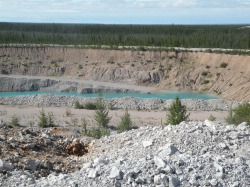Mining and the Social Economy in Northern Canada

Working with Professor Arn Keeling (MUN Geography) and MA alumnus Jean Sebastien-Boutet (MUN Geography), History Professor John Sandlos has just published a book chapter on mining and the social economy in the Canadian North. As part of the collection, Northern Communities Working Together, edited by Chris Southcott, the chapter highlights economic and social change at three historical northern mines: Pine Point, NWT; Rankin Inlet, Nunavut; and Schefferville, Quebec. The chapter draws on rich oral history sources that the three authors collected at each of these locations. This evidence suggests that the introduction of mining did not destroy older economic pursuits such as hunting and trapping. Instead, Aboriginal people often moved strategically between wage and subsitence labour, taking advantage of mineral and fur booms to offset price declines in either sector. Those interviewed for this project provide a rich testament of how Aboriginal people adjusted and adapted to new economic institutions that accompanied the advent of mining in particular regions. The book is an outgrowth of a much larger collaborative project on the social economy funded through the Social Sciences and Humanities Research Council of Canada (SSHRC).